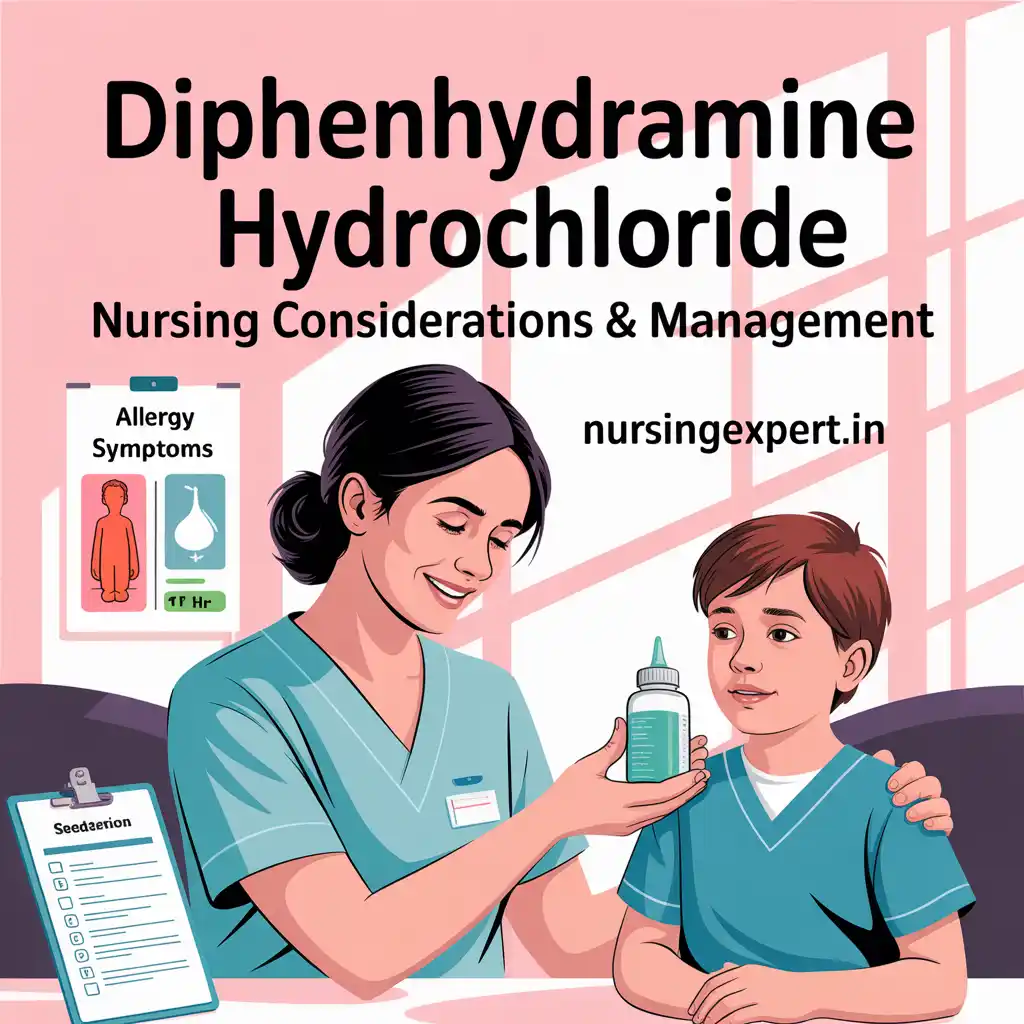Diphenhydramine hydrochloride, widely recognized under its brand name Benadryl, stands as a cornerstone in pharmacology due to its multifaceted applications. As a first-generation antihistamine, it is employed to manage allergic reactions, motion sickness, insomnia, and extrapyramidal symptoms. Its ability to induce sedation and its anticholinergic effects, however, necessitate meticulous oversight by nurses to balance therapeutic benefits against potential risks. This article offers an exhaustive exploration of diphenhydramine from a nursing perspective, equipping healthcare professionals with the knowledge to administer it safely and effectively across diverse patient populations.
Thank you for reading this post, don't forget to subscribe!
Introduction
Since its synthesis in 1943 by George Rieveschl, diphenhydramine has evolved from an experimental compound to a staple in clinical practice. Initially developed to combat histamine-mediated allergic responses, its sedative properties—stemming from its ability to cross the blood-brain barrier—distinguish it from newer antihistamines. This dual action has broadened its utility, making it a go-to medication for conditions ranging from hives to sleep disturbances. For nurses, understanding diphenhydramine’s pharmacology and its implications is critical to ensuring patient safety, particularly given its potential for side effects like drowsiness and anticholinergic toxicity.


This guide delves into every facet of diphenhydramine use, from its historical context to practical nursing strategies, providing a resource that is both educational and actionable for nursing students and seasoned practitioners alike.
Drug Overview
Generic Name
- Diphenhydramine hydrochloride
Common Brand Names
- Benadryl
- Nytol
- Sominex
- Unisom (select formulations)
Classification
- First-generation H1 receptor antagonist (antihistamine)
- Anticholinergic agent
- Sedative-hypnotic
Mechanism of Action
Diphenhydramine exerts its effects by competitively inhibiting histamine H1 receptors, thereby alleviating symptoms such as itching, sneezing, and rhinorrhea associated with allergic reactions. Its penetration into the central nervous system (CNS) results in sedation, making it valuable for insomnia and motion sickness. Additionally, its anticholinergic properties suppress acetylcholine activity, reducing secretions and muscle spasms, which aids in managing extrapyramidal symptoms induced by antipsychotics.
Historical Context
Approved by the FDA in 1946, diphenhydramine was among the first antihistamines available over-the-counter, revolutionizing allergy management. Its sedative effects, initially a side effect, became a therapeutic advantage, positioning it as a versatile drug in both acute and chronic care settings.
Indications
Diphenhydramine’s broad therapeutic profile stems from its antihistaminic, sedative, and anticholinergic actions. Below are its primary indications, each tied to specific pathophysiological mechanisms.
Approved Uses
- Allergic Reactions: Effective against allergic rhinitis, urticaria, and pruritus by blocking histamine’s inflammatory effects.
- Motion Sickness: Mitigates nausea and vertigo by suppressing vestibular stimulation in the inner ear.
- Insomnia: Promotes sleep through CNS depression, ideal for short-term use.
- Extrapyramidal Symptoms (EPS): Reduces drug-induced movement disorders (e.g., dystonia) by counteracting dopamine imbalances.
Off-Label Uses
- Nausea and Vomiting: Occasionally used beyond motion sickness, though evidence is limited.
- Pruritus from Non-Allergic Causes: Relieves itching from insect bites or mild dermatoses.
- Anaphylaxis Adjunct: Supports epinephrine in severe allergic emergencies, though not a primary treatment.
Nurses must recognize these indications to tailor interventions and monitor outcomes effectively, ensuring alignment with the patient’s clinical needs.
Dosage and Administration
Diphenhydramine’s availability in various forms—oral, injectable, and topical—requires precise administration to optimize efficacy and minimize complications.
Dosage Forms and Routes
- Oral: Tablets (25 mg, 50 mg), capsules, liquid (12.5 mg/5 mL)
- Injectable: IM or IV (50 mg/mL)
- Topical: Creams, gels (1–2% concentration)
Adult Dosage Guidelines
- Allergic Reactions:
- Oral: 25–50 mg every 4–6 hours (max 300 mg/day)
- IM/IV: 10–50 mg per dose (max 400 mg/day)
- Motion Sickness:
- Oral: 25–50 mg 30 minutes before travel, then every 4–6 hours
- Insomnia:
- Oral: 50 mg 30 minutes before bedtime
- Extrapyramidal Symptoms:
- Oral: 25–50 mg every 4–6 hours
- IM/IV: 10–50 mg as needed
Pediatric Dosage Guidelines
- Allergic Reactions/Motion Sickness:
- Oral or injectable: 1–1.25 mg/kg every 4–6 hours (ages 2–12)
- Caution: Contraindicated in children under 2 due to risk of respiratory depression.
Administration Techniques
- Oral: Administer with water; food is optional but may reduce GI upset. Use a calibrated device for liquids.
- IV: Dilute in 10 mL normal saline; infuse slowly (over 10–15 minutes) to avoid hypotension or tachycardia.
- IM: Inject into a large muscle (e.g., gluteus maximus); rotate sites to prevent irritation.
- Topical: Apply thinly to affected areas; avoid broken skin or mucous membranes.
Nurses must double-check dosages, especially in pediatrics, and ensure proper technique to prevent administration-related adverse events.
Nursing Considerations
Effective management of diphenhydramine hinges on thorough assessment, proactive interventions, and robust patient education.
Pre-Administration Assessment
- Medical History Review:
- Contraindications: Narrow-angle glaucoma, prostatic hypertrophy, peptic ulcer, or asthma.
- Risk Factors: History of seizures, cardiovascular disease, or thyroid dysfunction.
- Medication Reconciliation:
- Identify CNS depressants, anticholinergics, or MAOIs that could amplify effects.
- Baseline Evaluation:
- Vital signs (BP, HR, RR)
- Mental status (alertness, orientation)
- Physical exam (e.g., bladder distension in males)
Nursing Interventions
- Sedation Management:
- Implement fall precautions: bed alarms, side rails, and assistance with mobility.
- Anticholinergic Effect Mitigation:
- Dry mouth: Offer ice chips or sugarless gum.
- Urinary retention: Monitor output; encourage voiding.
- Constipation: Advise dietary fiber or stool softeners.
- Injection Oversight:
- IV: Watch for phlebitis or extravasation.
- IM: Assess for pain or tissue damage.
- Paradoxical Reaction Monitoring:
- In children, note hyperactivity or agitation; adjust care accordingly.
Patient Education
- Safety Precautions:
- “Avoid driving or operating heavy machinery until you know how this affects you.”
- Substance Interactions:
- “Do not drink alcohol or take sedatives while using this medication.”
- Dosage Compliance:
- “Follow the prescribed dose exactly; taking more can be dangerous.”
- Symptom Reporting:
- “Call your provider if you experience confusion, rapid heartbeat, or breathing problems.”
- Topical Application:
- “Wash your hands after applying and don’t cover the area unless instructed.”
Adverse Effects
Diphenhydramine’s side effects range from mild inconveniences to severe complications, requiring nurses to be adept at recognition and response.
Common Side Effects
- Drowsiness: Peaks within 1–3 hours; may persist in the elderly.
- Dry Mouth/Xerostomia: Anticholinergic-induced; usually self-limiting.
- Constipation: Reduced peristalsis; manageable with hydration.
- Blurred Vision: Temporary; resolves with discontinuation.
- Urinary Hesitancy: More prevalent in men with BPH.
Serious Adverse Reactions
- Paradoxical Excitation: Common in children; manifests as restlessness or insomnia.
- Delirium: Elderly patients may exhibit confusion or hallucinations.
- Cardiovascular Effects: Tachycardia or arrhythmias with rapid IV push.
- Seizures: Rare unless overdosed.
- Hypersensitivity: Anaphylaxis to the drug itself is uncommon but possible.
Monitoring Strategies
- Observe for dose-dependent effects.
- Differentiate benign side effects from overdose signs (e.g., severe lethargy vs. normal sedation).
- Document and report unexpected reactions promptly.
Special Populations
Tailoring diphenhydramine use to specific groups is essential to mitigate risks and enhance benefits.
Elderly Patients
- Pharmacokinetics: Slower metabolism increases sensitivity.
- Risks: Higher incidence of confusion, falls, and urinary retention.
- Recommendations: Start at 25 mg; titrate cautiously.
Pediatric Patients
- Unique Response: May experience excitation rather than sedation.
- Safety: Avoid in neonates and infants under 2 years.
- Dosing: Use weight-based calculations; verify with a second nurse.
Pregnant Women
- FDA Category B: No evidence of fetal harm, but data is limited.
- Late Pregnancy: Risk of neonatal sedation or withdrawal.
- Guidance: Use only if benefits outweigh risks.
Breastfeeding Mothers
- Milk Transfer: Small amounts excreted; may sedate or agitate infants.
- Alternatives: Consider cetirizine or loratadine if feasible.
Drug Interactions
Diphenhydramine’s interactions can amplify its effects or compromise patient safety.
Key Interactions
- CNS Depressants: Synergistic sedation with opioids, benzodiazepines, or alcohol.
- Anticholinergics: Additive effects with drugs like oxybutynin or tricyclics.
- MAOIs: Enhanced anticholinergic toxicity; contraindicated within 14 days.
- CYP2D6 Inhibitors: Increased plasma levels with fluoxetine or quinidine.
Nursing Actions
- Conduct a thorough medication history.
- Adjust doses or timing to minimize overlap.
- Educate patients on over-the-counter risks (e.g., cold medicines with similar ingredients).
Overdose Management
Overdose can occur with intentional misuse or accidental excess, presenting a medical emergency.
Signs and Symptoms
- Extreme drowsiness or coma
- Hallucinations or psychosis
- Seizures or tremors
- Hyperthermia
- Cardiac irregularities
Emergency Protocol
- Initial Response: Ensure airway patency; monitor vitals.
- Decontamination: Administer activated charcoal if within 1–2 hours of ingestion.
- Supportive Care: IV fluids, cooling blankets, or oxygen as needed.
- Specialized Treatment: Physostigmine for severe anticholinergic symptoms (physician-ordered).
- Escalation: Transfer to ICU or contact poison control for severe cases.
Case Study: Applying Knowledge
Scenario: A 10-year-old child with a bee sting allergy receives 25 mg IV diphenhydramine. Post-administration, he becomes agitated and restless.
Nursing Response
- Assessment: Recognize paradoxical excitation; check vitals.
- Intervention: Calm the environment; reassure the child and parents.
- Education: Inform caregivers this is a possible reaction that should subside.
This illustrates the need for adaptability and patient-specific care.
Recent Developments
Research continues to explore diphenhydramine’s potential in areas like chemotherapy-induced nausea and chronic pain. Novel delivery systems, such as intranasal formulations, are under investigation, promising faster relief in acute settings. Nurses should monitor these advancements to integrate evidence-based updates into practice.
Conclusion
Diphenhydramine hydrochloride remains a vital tool in nursing care, offering relief across a spectrum of conditions. Its complexity, however, demands a nuanced approach to administration, monitoring, and education. By mastering its considerations—from dosage precision to overdose response—nurses can harness its benefits while safeguarding patient well-being, ensuring it remains a trusted ally in healthcare.


